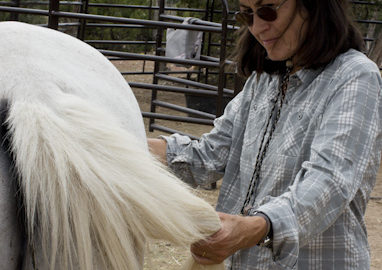When there is tightness or restriction in the spine, often it’s helpful to work with the tail. In Equine Body Balance, we have a few ways of working with it.
The horse’s tail is a continuation of the spinal column. The horse’s spine includes the entire “axial skeletal” framework: from the skull along the vertebrae, and the attachment to the pelvis, all the way to the tail, which includes the coccygeal vertebrae from caudal end of the sacrum to the tailhead down (15-20 coccygeal vertebrae). It contains the nervous system continuation of the brain, the spinal cord.
We are working with the availability of the tail, making sure it is always flexible and willing and there is no yanking or pulling involved.
The horse in the following video was very laminitic at the time and could not move much at all. Movement is life to horses. The work done with the tail and ribcage was designed to bring more comfort in the body so he could move more. While most of the attention is focused on the feet of the laminitic horse, the entire body of the horse is struggling to deal with the pain and making compensations. Fear of not being able to move is also a part of the equation. If we can bring even slight movement into the body, the animal will feel better.
The techniques offered here are also helpful during the cold weather for horses who are confined or unable to move much because of icy or muddy footing. They can also help liven up the tail for horses who wear blankets.



